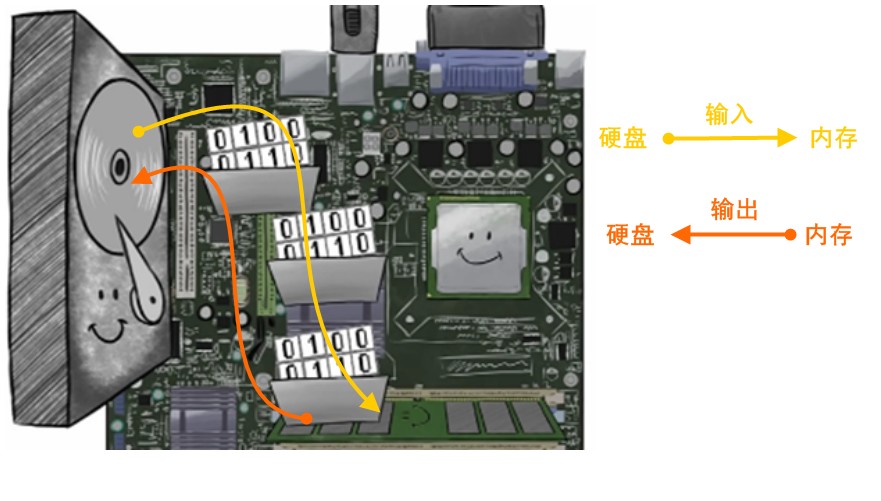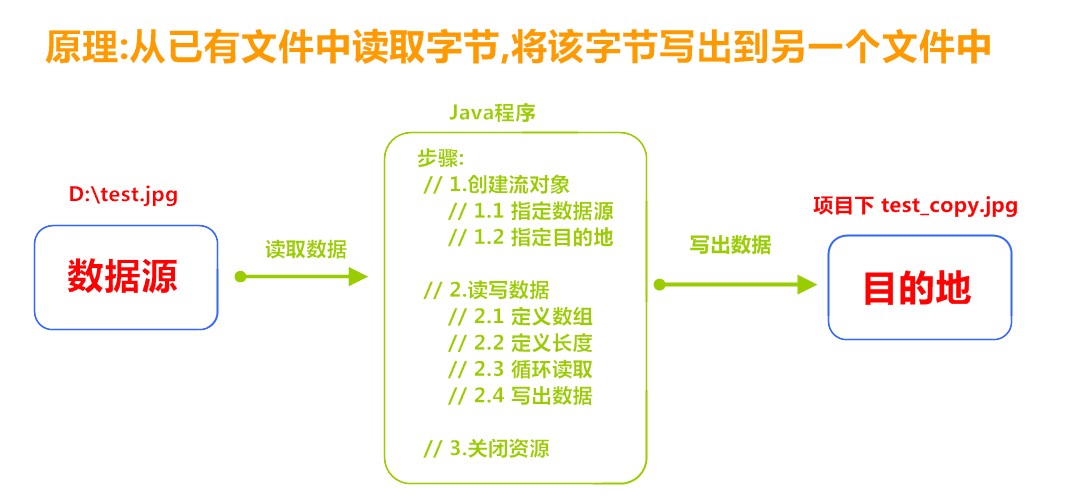1 IO概述
1.1 什么是IO
生活中,你肯定经历过这样的场景。当你编辑一个文本文件,忘记了ctrl+s ,可能文件就白白编辑了。当你电脑上插入一个U盘,可以把一个视频,拷贝到你的电脑硬盘里。那么数据都是在哪些设备上的呢?键盘、内存、硬盘、外接设备等等。
我们把这种数据的传输,可以看做是一种数据的流动,按照流动的方向,以内存为基准,分为输入input 和输出output ,即流向内存是输入流,流出内存的输出流。
Java中I/O操作主要是指使用java.io包下的内容,进行输入、输出操作。输入也叫做读取数据,输出也叫做作写出数据。
1.2 IO的分类
根据数据的流向分为:输入流和输出流。
- 输入流 :把数据从
其他设备上读取到内存中的流。 - 输出流 :把数据从
内存中写出到其他设备上的流。
格局数据的类型分为:字节流和字符流。
- 字节流 :以字节为单位,读写数据的流。
- 字符流 :以字符为单位,读写数据的流。
1.3 IO的流向说明图解
1.4 顶级父类们
| 输入流 | 输出流 | |
|---|---|---|
| 字节流 | 字节输入流 InputStream |
字节输出流 OutputStream |
| 字符流 | 字符输入流 Reader |
字符输出流 Writer |
2 字节流
2.1 一切皆为字节
一切文件数据(文本、图片、视频等)在存储时,都是以二进制数字的形式保存,都一个一个的字节,那么传输时一样如此。所以,字节流可以传输任意文件数据。在操作流的时候,我们要时刻明确,无论使用什么样的流对象,底层传输的始终为二进制数据。
2.2 字节输出流【OutputStream】
java.io.OutputStream抽象类是表示字节输出流的所有类的超类,将指定的字节信息写出到目的地。它定义了字节输出流的基本共性功能方法。
public void close():关闭此输出流并释放与此流相关联的任何系统资源。public void flush():刷新此输出流并强制任何缓冲的输出字节被写出。public void write(byte[] b):将 b.length字节从指定的字节数组写入此输出流。public void write(byte[] b, int off, int len):从指定的字节数组写入 len字节,从偏移量 off开始输出到此输出流。public abstract void write(int b):将指定的字节输出流。
小贴士:
close方法,当完成流的操作时,必须调用此方法,释放系统资源。
2.3 FileOutputStream类
OutputStream有很多子类,我们从最简单的一个子类开始。
java.io.FileOutputStream类是文件输出流,用于把内存中的数据写入到硬盘的文件中。
构造方法
public FileOutputStream(File file):创建文件输出流以写入由指定的 File对象表示的文件。public FileOutputStream(String name): 创建文件输出流以指定的名称写入文件。
当你创建一个流对象时,必须传入一个文件路径。该路径下,如果没有这个文件,会创建该文件。如果有这个文件,会清空这个文件的数据。
- 构造举例,代码如下:
1 | public class FileOutputStreamConstructor throws IOException { |
写出字节数据
字节输出流的使用步骤
1.创建一个FileOutputStream对象,构造方法中传递写入数据的目的地
2.调用FileOutputStream对象中的方法write,把数据写入到文件中
3.释放资源(流使用会占用一定的内存,使用完毕要把内存清空,提供程序的效率)
写入数据的原理(内存–>硬盘)
java程序–>JVM(java虚拟机)–>OS(操作系统)–>OS调用写数据的方法–>把数据写入到文件中
①写出字节
write(int b) 方法,每次可以写出一个字节数据,代码使用演示:
1 | public class FOSWrite { |
小贴士:
- 虽然参数为int类型四个字节,但是只会保留一个字节的信息写出。
- 流操作完毕后,必须释放系统资源,调用close方法,千万记得。
②写出字节数组
write(byte[] b),每次可以写出数组中的数据,代码使用演示:
public void write(byte[] b):将b.length字节从指定的字节数组写入此输出流。
一次写多个字节:
如果写的第一个字节是正数(0-127),那么显示的时候会查询ASCII表
如果写的第一个字节是负数,那第一个字节会和第二个字节,两个字节组成一个中文显示,查询系统默认码表(GBK)
1 | public class FOSWrite { |
③写出指定长度字节数组
write(byte[] b, int off, int len) ,每次写出从off索引开始,len个字节,代码使用演示:
1 | public class FOSWrite { |
数据追加续写
经过以上的演示,每次程序运行,创建输出流对象,都会清空目标文件中的数据。如何保留目标文件中数据,还能继续添加新数据呢?
public FileOutputStream(File file, boolean append): 创建文件输出流以写入由指定的 File对象表示的文件。public FileOutputStream(String name, boolean append): 创建文件输出流以指定的名称写入文件。
这两个构造方法,参数中都需要传入一个boolean类型的值,true 表示追加数据,false 表示清空原有数据。这样创建的输出流对象,就可以指定是否追加续写了,代码使用演示:
1 | public class FOSWrite { |
写出换行
Windows系统里,换行符号是\r\n 。把
以指定是否追加续写了,代码使用演示:
1 | public class FOSWrite { |
- 回车符
\r和换行符\n:
- 回车符:回到一行的开头(return)。
- 换行符:下一行(newline)。
- 系统中的换行:
- Windows系统里,每行结尾是
回车+换行,即\r\n;- Unix系统里,每行结尾只有
换行,即\n;- Mac系统里,每行结尾是
回车,即\r。从 Mac OS X开始与Linux统一。
2.4 字节输入流【InputStream】
java.io.InputStream抽象类是表示字节输入流的所有类的超类,可以读取字节信息到内存中。它定义了字节输入流的基本共性功能方法。
public void close():关闭此输入流并释放与此流相关联的任何系统资源。public abstract int read(): 从输入流读取数据的下一个字节。public int read(byte[] b): 从输入流中读取一些字节数,并将它们存储到字节数组 b中 。
小贴士:
close方法,当完成流的操作时,必须调用此方法,释放系统资源。
2.5 FileInputStream类
java.io.FileInputStream类是文件输入流,从文件中读取字节。
构造方法
FileInputStream(File file): 通过打开与实际文件的连接来创建一个 FileInputStream ,该文件由文件系统中的 File对象 file命名。FileInputStream(String name): 通过打开与实际文件的连接来创建一个 FileInputStream ,该文件由文件系统中的路径名 name命名。
当你创建一个流对象时,必须传入一个文件路径。该路径下,如果没有该文件,会抛出FileNotFoundException 。
- 构造举例,代码如下:
1 | public class FileInputStreamConstructor throws IOException{ |
读取字节数据
- 读取字节:
read方法,每次可以读取一个字节的数据,提升为int类型,读取到文件末尾,返回-1,代码使用演示:
1 | public class FISRead { |
循环改进读取方式,代码使用演示:
1 | public class FISRead { |
小贴士:
- 虽然读取了一个字节,但是会自动提升为int类型。
- 流操作完毕后,必须释放系统资源,调用close方法,千万记得。
- 使用字节数组读取:
read(byte[] b),每次读取b的长度个字节到数组中,返回读取到的有效字节个数,读取到末尾时,返回-1,代码使用演示:
1 | public class FISRead { |
错误数据d,是由于最后一次读取时,只读取一个字节e,数组中,上次读取的数据没有被完全替换,所以要通过len ,获取有效的字节,代码使用演示:
1 | public class FISRead { |
小贴士:
使用数组读取,每次读取多个字节,减少了系统间的IO操作次数,从而提高了读写的效率,建议开发中使用。
2.6 字节流练习:图片复制
复制原理图解
案例实现
复制图片文件,代码使用演示:
1 | public class Copy { |
小贴士:
流的关闭原则:先开后关,后开先关。
3 字符流
当使用字节流读取文本文件时,可能会有一个小问题。就是遇到中文字符时,可能不会显示完整的字符,那是因为一个中文字符可能占用多个字节存储。所以Java提供一些字符流类,以字符为单位读写数据,专门用于处理文本文件。
3.1 字符输入流【Reader】
java.io.Reader抽象类是表示用于读取字符流的所有类的超类,可以读取字符信息到内存中。它定义了字符输入流的基本共性功能方法。
public void close():关闭此流并释放与此流相关联的任何系统资源。public int read(): 从输入流读取一个字符。public int read(char[] cbuf): 从输入流中读取一些字符,并将它们存储到字符数组 cbuf中 。
3.2 FileReader类
java.io.FileReader类是读取字符文件的便利类。构造时使用系统默认的字符编码和默认字节缓冲区。
小贴士:
字符编码:字节与字符的对应规则。Windows系统的中文编码默认是GBK编码表。
idea中UTF-8
字节缓冲区:一个字节数组,用来临时存储字节数据。
构造方法
FileReader(File file): 创建一个新的 FileReader ,给定要读取的File对象。FileReader(String fileName): 创建一个新的 FileReader ,给定要读取的文件的名称。
当你创建一个流对象时,必须传入一个文件路径。类似于FileInputStream 。
- 构造举例,代码如下:
1 | public class FileReaderConstructor throws IOException{ |
读取字符数据
- 读取字符:
read方法,每次可以读取一个字符的数据,提升为int类型,读取到文件末尾,返回-1,循环读取,代码使用演示:
1 | public class FRRead { |
小贴士:虽然读取了一个字符,但是会自动提升为int类型。
- 使用字符数组读取:
read(char[] cbuf),每次读取b的长度个字符到数组中,返回读取到的有效字符个数,读取到末尾时,返回-1,代码使用演示:
1 | public class FRRead { |
获取有效的字符改进,代码使用演示:
1 | public class FISRead { |
3.3 字符输出流【Writer】
java.io.Writer抽象类是表示用于写出字符流的所有类的超类,将指定的字符信息写出到目的地。它定义了字节输出流的基本共性功能方法。
void write(int c)写入单个字符。void write(char[] cbuf)写入字符数组。abstract void write(char[] cbuf, int off, int len)写入字符数组的某一部分,off数组的开始索引,len写的字符个数。void write(String str)写入字符串。void write(String str, int off, int len)写入字符串的某一部分,off字符串的开始索引,len写的字符个数。void flush()刷新该流的缓冲。void close()关闭此流,但要先刷新它。
3.4 FileWriter类
java.io.FileWriter类是写出字符到文件的便利类。构造时使用系统默认的字符编码和默认字节缓冲区。
构造方法
FileWriter(File file): 创建一个新的 FileWriter,给定要读取的File对象。FileWriter(String fileName): 创建一个新的 FileWriter,给定要读取的文件的名称。
当你创建一个流对象时,必须传入一个文件路径,类似于FileOutputStream。
- 构造举例,代码如下:
1 | public class FileWriterConstructor { |
基本写出数据
写出字符:write(int b) 方法,每次可以写出一个字符数据,代码使用演示:
1 | public class FWWrite { |
小贴士:
- 虽然参数为int类型四个字节,但是只会保留一个字符的信息写出。
- 未调用close方法,数据只是保存到了缓冲区,并未写出到文件中。
关闭和刷新
因为内置缓冲区的原因,如果不关闭输出流,无法写出字符到文件中。但是关闭的流对象,是无法继续写出数据的。如果我们既想写出数据,又想继续使用流,就需要flush 方法了。
flush:刷新缓冲区,流对象可以继续使用。close:先刷新缓冲区,然后通知系统释放资源。流对象不可以再被使用了。
代码使用演示:
1 | public class FWWrite { |
小贴士:即便是flush方法写出了数据,操作的最后还是要调用close方法,释放系统资源。
写出其他数据
- 写出字符数组 :
write(char[] cbuf)和write(char[] cbuf, int off, int len),每次可以写出字符数组中的数据,用法类似FileOutputStream,代码使用演示:
1 | public class FWWrite { |
- 写出字符串:
write(String str)和write(String str, int off, int len),每次可以写出字符串中的数据,更为方便,代码使用演示:
1 | public class FWWrite { |
- 续写和换行:操作类似于FileOutputStream。
1 | public class FWWrite { |
小贴士:字符流,只能操作文本文件,不能操作图片,视频等非文本文件。
当我们单纯读或者写文本文件时 使用字符流 其他情况使用字节流
4 IO异常的处理
JDK7前处理
之前的入门练习,我们一直把异常抛出,而实际开发中并不能这样处理,建议使用try...catch...finally 代码块,处理异常部分,代码使用演示:
1 | public class HandleException1 { |
JDK7的处理(扩展知识点了解内容)
还可以使用JDK7优化后的try-with-resource 语句,该语句确保了每个资源在语句结束时关闭。所谓的资源(resource)是指在程序完成后,必须关闭的对象。
格式:
1 | try (创建流对象语句,如果多个,使用';'隔开) { |
代码使用演示:
1 | public class HandleException2 { |
JDK9的改进(扩展知识点了解内容)
JDK9中try-with-resource 的改进,对于引入对象的方式,支持的更加简洁。被引入的对象,同样可以自动关闭,无需手动close,我们来了解一下格式。
改进前格式:
1 | // 被final修饰的对象 |
改进后格式:
1 | // 被final修饰的对象 |
改进后,代码使用演示:
1 | public class TryDemo { |
5 属性集
5.1 概述
java.util.Properties 继承于Hashtable ,来表示一个持久的属性集。它使用键值结构存储数据,每个键及其对应值都是一个字符串。该类也被许多Java类使用,比如获取系统属性时,System.getProperties 方法就是返回一个Properties对象。
5.2 Properties类
构造方法
public Properties():创建一个空的属性列表。
基本的存储方法
public Object setProperty(String key, String value): 保存一对属性。public String getProperty(String key):使用此属性列表中指定的键搜索属性值。public Set<String> stringPropertyNames():所有键的名称的集合。
1 | public class ProDemo { |
与流相关的方法
public void load(InputStream inStream): 从字节输入流中读取键值对。
参数中使用了字节输入流,通过流对象,可以关联到某文件上,这样就能够加载文本中的数据了。文本数据格式:
1 | filename=a.txt |
加载代码演示:
1 | public class ProDemo2 { |
小贴士:文本中的数据,必须是键值对形式,可以使用空格、等号、冒号等符号分隔。









